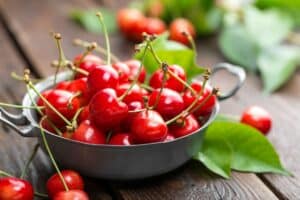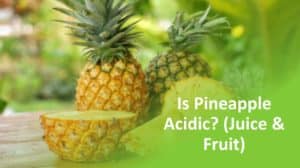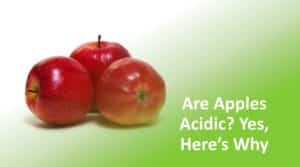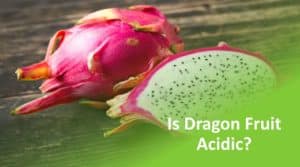Banana — acidic or alkaline? Well, it depends.
The ones bought from the store often have a pH of 4.50 – 5.20, which is slightly acidic. The pH of burro bananas, on the other hand, is 7.6, making them alkaline.
The green variety is considered to be more acidic than the mature variety, as bananas tend to shift towards a more alkaline pH value as they age. Their acidity also changes during cooking.
There are lots of things to cover — or peel off. So let’s get started.

pH Values of Bananas
Ripe bananas hover between acidic and alkaline, with a pH ranging up to 4.50 – 7.6, depending on the type.
A pH scale measures how acidic or alkaline a compound (like a banana) is. It’s a chemical detector for hydronium and hydrogen ions, with numbers ranging from 0 to 14. The potency of acids varies from 0 to 7, with 0 being the most powerful.
Blueberries, for example, are acidic because their pH is quite low, around 3.33. A base or an alkaline compound is anything between 7 and 14. A compound that has a pH of 7 is considered neutral, like popcorn.
However, the degree of acidity of bananas, in particular, fluctuates as they mature. When they are green, their acidity is more potent, with a pH range of 4.4 to 5.5. This explains why mature yellow ones are sweeter and more mellow in flavor, whereas green ones have a more sour flavor.
pH Values of Different Banana Types
There are more than a thousand varieties of this tropical fruit with different levels of acidity. Even though it’s impossible to know the pH value of all types, looking at the most common ones may help.
The kind that’s most frequently available in supermarkets is the Cavendish type, with a pH of about 5.5, which is somewhat acidic. Apple bananas have a pH of 5.8, which is also quite acidic. The pH of red ones is higher, hovering at 6.2, while the pH of plantains is even higher, at 6.5.
Burro and baby bananas are the top performers in terms of low acidity. They have exceptional pH ratings. Burros have a pH of 7.6, whereas the latter rank at 7.3.
Do Bananas Cause Acid Reflux?
No, they don’t. In fact, they may be very helpful in preventing acid reflux. Let’s see how.
Acid reflux is a digestive condition. When the lower esophageal sphincter (LES) fails to completely close, stomach acid leaks back into the esophagus, causing heartburn. The symptoms include a burning feeling in the upper abdomen or chest, followed by bloating and nausea.

So, how can these sweet yellow fruits help with the burning sensation? This fruit’s high potassium content is thought to assist digestion and prevent acids from entering the esophagus. Additionally, its soluble and insoluble fiber increases metabolism. They also contain vitamin B, which supports esophageal strength.
Overall, they help to preserve the stomach lining by encouraging the production of mucus, which acts as a buffer against stomach acids. Furthermore, the protease inhibitors found in these fruits kill certain dangerous bacteria in the stomach. All of these qualities allow them to be used as a natural antacid to treat acid reflux.
Can Overripe Bananas Cause Acid Reflux?
Ripe fruits can be quite acidic since overripe enzymes convert complex carbohydrates into simple sugars, enhancing their acidity. A ripe banana has a pH of about 5.8, making it moderately acidic.
Luckily, they aren’t a threat to your heartburn if eaten in small amounts, as opposed to other acidic foods, like lemons (pH up to 2.6).
Still, it’s better to stay away from overripe ones if you are concerned about acid reflux.
Can Cooked Bananas Cause Acid Reflux?
It depends on the way you cook it. They are most alkaline when eaten raw. However, digesting raw bananas can be tough, and you may feel bloated and gassy. If you need to cook them, boiling is the best method. Boiling breaks down the starch, thus making them easier to digest.
Avoid frying them since fried foods have the worst impact on your acidity levels.
Which Banana Is the Best for Acid Reflux?
For starters, avoid unripe or overripe ones. Green bananas, in particular, are known to cause bloating and gas that may eventually lead to acid reflux.
Instead, eat them ripe — and if they belong to the burro variety, even better. Burros are rich in potassium, an essential electrolyte for preserving the pH balance of the body.
They also contain low quantities of sodium, another important electrolyte. This combo helps body pH remain alkaline, preventing acidity. Burros also contain a lot of dietary fiber, which helps the body remove toxins.
You can try to relieve your acid reflux symptoms with them but avoid excessive consumption as they can also cause bloating, gas, and abdominal pain, due to the high content of insoluble fiber.
Conclusion
Now that you know these fruits are alkaline, you may find them more appealing. But remember that they’re not all equally alkaline. Play it safe, and grab a bite of baby (pH of 7.3) or burro bananas (pH 7.6). Remember that green ones are more acidic than ripe ones.
Cooking them increases their acidity, but boiling can help with digestion problems. Avoid eating fried ones as they will most likely give you heartburn.
Last but not least, eat them in moderation rather than in excess. They are an exceptional ingredient for smoothies and may help balance out the pH levels of other acidic fruits, like strawberries.






